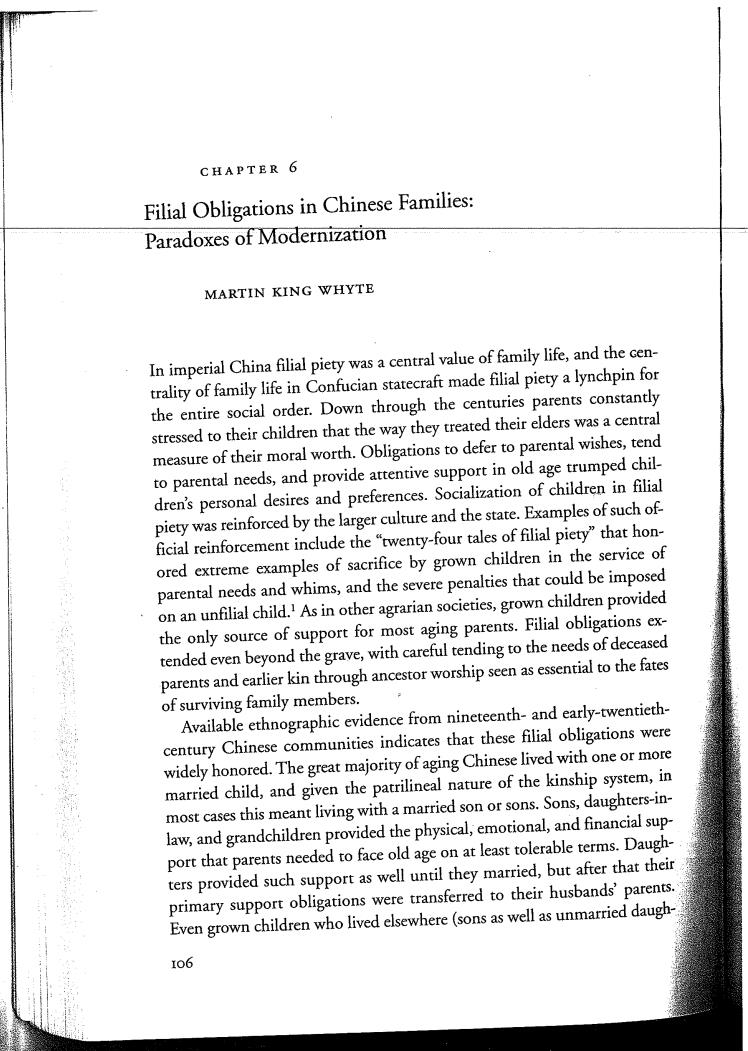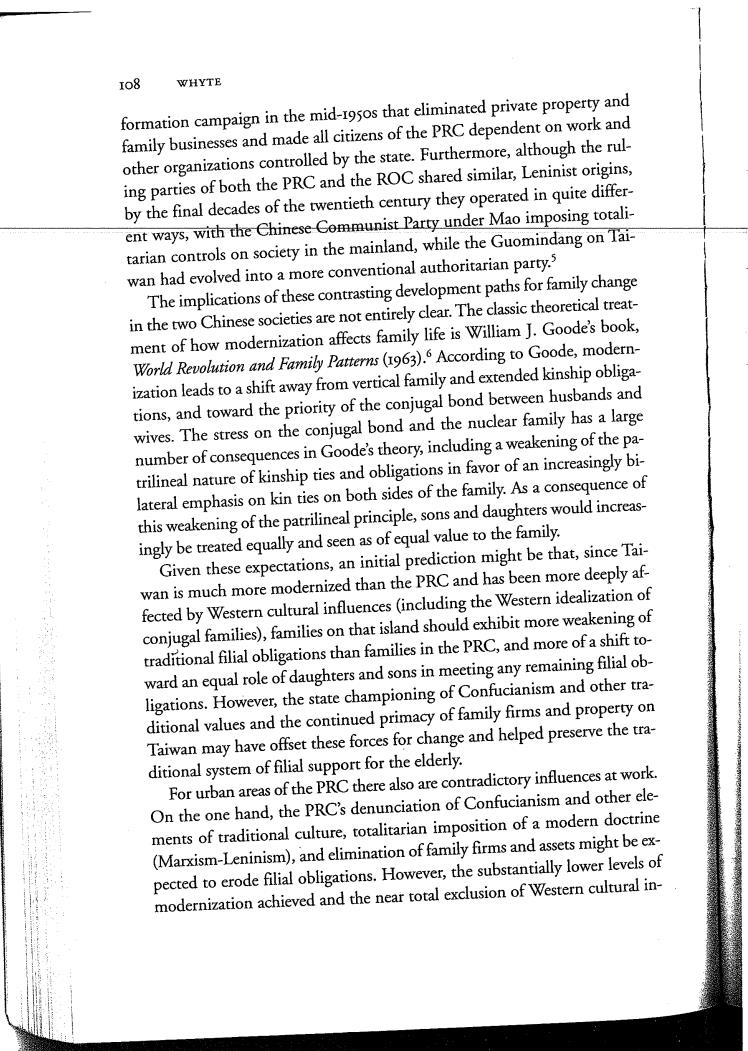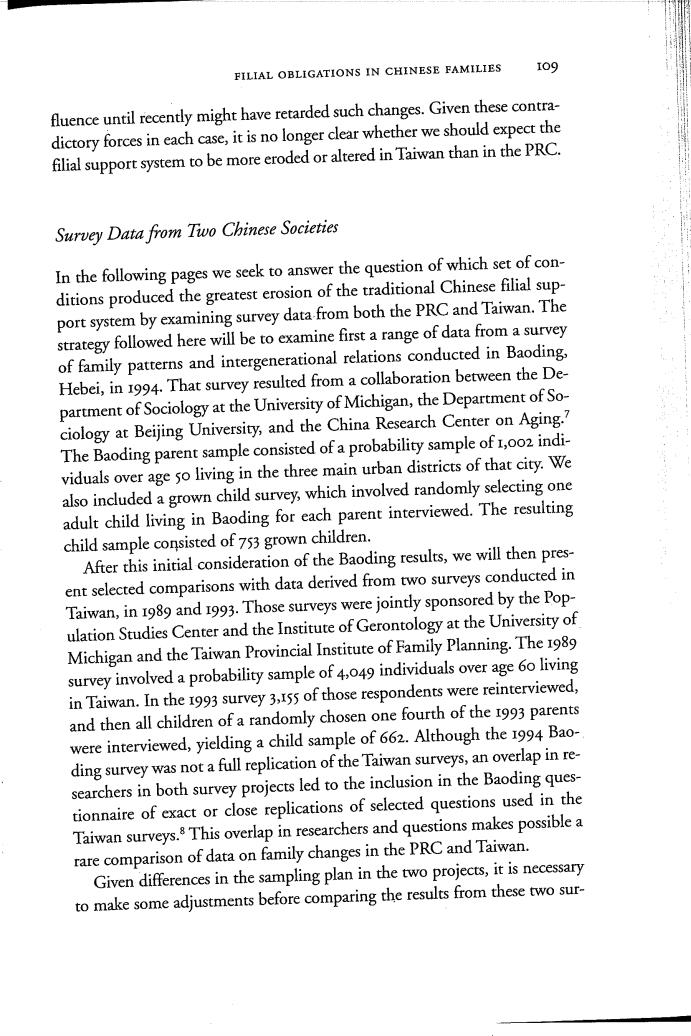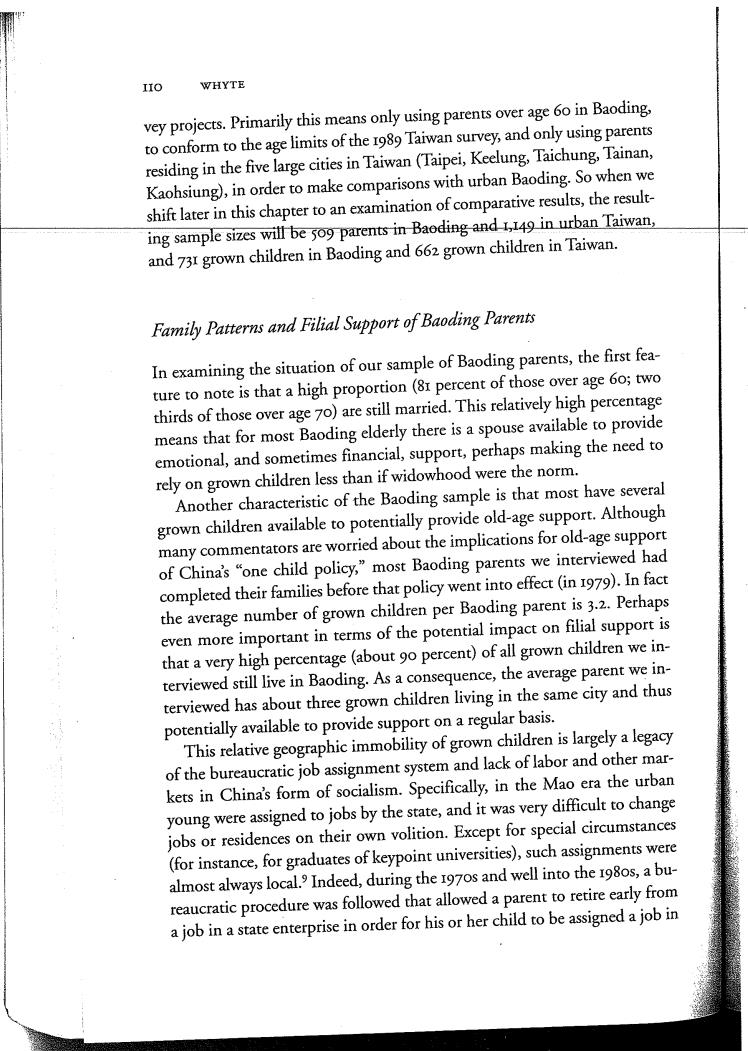
CHAPTER 6 Filial Obligations in Chinese Families: Paradoxes of Modernization MARTIN KING WHYTE In imperial China filial piety was a central value of family life,and the cen- trality of family life in Confucian statecraft made filial piety a lynchpin for the entire social order.Down through the centuries parents constantly stressed to their children that the way they treated their elders was a central measure of their moral worth.Obligations to defer to parental wishes,tend to parental needs,and provide attentive support in old age trumped chil- dren's personal desires and preferences.Socialization of children in filial piety was reinforced by the larger culture and the state.Examples of such of- ficial reinforcement include the“twenty-four tales of filial piety"that hon- ored extreme examples of sacrifice by grown children in the service of parental needs and whims,and the severe penalties that could be imposed on an unfilial child.As in other agrarian societies,grown children provided the only source of support for most aging parents.Filial obligations ex- tended even beyond the grave,with careful tending to the needs of deceased parents and earlier kin through ancestor worship seen as essential to the fates of surviving family members. Available ethnographic evidence from nineteenth-and early-twentieth- century Chinese communities indicates that these filial obligations were widely honored.The great majority of aging Chinese lived with one or more married child,and given the patrilineal nature of the kinship system,in most cases this meant living with a married son or sons.Sons,daughters-in- law,and grandchildren provided the physical,emotional,and financial sup- port that parents needed to face old age on at least tolerable terms.Daugh- ters provided such support as well until they married,but after that their primary support obligations were transferred to their husbands'parents. Even grown children who lived elsewhere (sons as well as unmarried daugh- I06

FILIAL OBLIGATIONS IN CHINESE FAMILIES I07 ters)shared in these obligations,with cash remittances from earnings,holi- day visits,and other filial acts expected.For most Chinese the main threat to security in old age came not from unfilial grown children,but from high mortality rates that left some of the elderly without any grown sons to pro- vide old-age support. The PRC and Taiwan:Two Contrasting Development Paths What has happened to this system of familial support for the elderly in the wake of the tumultuous changes of the twentieth century?How did obliga- tions of grown children toward their aging parents survive the collapse of the imperial system,the chaos of the warlord period,the attacks against Confu- cianism of the May Fourth movement,World War II and the Civil War,and the political lurches and rapid pace of economic change after 1949?Since 1949 China has been divided into two antagonistic political regimes:the People's Republic of China(hereinafter PRC)on the mainland,and the Re- public of China on Taiwan (hereinafter Taiwan).In which Chinese setting has the traditional system of filial support for the elderly been eroded,or al- tered,the most?In this chapter we present comparative survey data from ur- ban areas in the PRC and Taiwan in an effort to answer these questions. These two political systems have pursued modernization in quite differ- ent ways.Broadly speaking,Taiwan pursued development in a market-based capitalist framework throughout,with close cultural and economic integra- tion into the global system dominated by Western societies.Until the 198os, Taiwan's economy grew much more rapidly than the PRC's,and today the island still has a much higher level of development(industrialization,ur- banization,universalization of education,and so on)than does the main- land.3 But in certain respects Taiwan's development took on atraditional" cast,as in the ROC portraying itself as a defender of Chinese traditional val- ues and Confucianism,and in the dominance of family-run enterprises in the island's economy. In contrast,the PRC largely closed itself off from economic and cultural involvement with the outside world until the end of the 197os,and its lead- ers regularly denounced traditional values,and Confucianism in particular, as"feudal"remnants that should be eliminated.In addition,the commit- ment of Mao Zedong and his colleagues to socialism led to a socialist trans-

1o8 WHYTE formation campaign in the mid-I9sos that eliminated private property and family businesses and made all citizens of the PRC dependent on work and other organizations controlled by the state.Furthermore,although the rul- ing parties of both the PRC and the ROC shared similar,Leninist origins, by the final decades of the twentieth century they operated in quite differ- ent ways,with the Chinese Cemmunist Party under Mao imposing totali- tarian controls on society in the mainland,while the Guomindang on Tai- wan had evolved into a more conventional authoritarian party.s The implications of these contrasting development paths for family change in the two Chinese societies are not entirely clear.The classic theoretical treat- ment of how modernization affects family life is William J.Goode's book, World Revolution and Family Patterns(1963).According to Goode,modern- ization leads to a shift away from vertical family and extended kinship obliga- tions,and toward the priority of the conjugal bond between husbands and wives.The stress on the conjugal bond and the nuclear family has a large number of consequences in Goode's theory,including a weakening of the pa- trilineal nature of kinship ties and obligations in favor of an increasingly bi- lateral emphasis on kin ties on both sides of the family.As a consequence of this weakening of the patrilineal principle,sons and daughters would increas- ingly be treated equally and seen as of equal value to the family. Given these expectations,an initial prediction might be that,since Tai- wan is much more modernized than the PRC and has been more deeply af- fected by Western cultural influences(including the Western idealization of conjugal families),families on that island should exhibit more weakening of traditional filial obligations than families in the PRC,and more of a shift to- ward an equal role of daughters and sons in meeting any remaining filial ob- ligations.However,the state championing of Confucianism and other tra- ditional values and the continued primacy of family firms and property on Taiwan may have offset these forces for change and helped preserve the tra- ditional system of filial support for the elderly. For urban areas of the PRC there also are contradictory influences at work. On the one hand,the PRC's denunciation of Confucianism and other ele- ments of traditional culture,totalitarian imposition of a modern doctrine (Marxism-Leninism),and elimination of family firms and assets might be ex- pected to erode filial obligations.However,the substantially lower levels of modernization achieved and the near total exclusion of Western cultural in-

FILIAL OBLIGATIONS IN CHINESE FAMILIES 109 fluence until recently might have retarded such changes.Given these contra- dictory forces in each case,it is no longer clear whether we should expect the filial support system to be more eroded or altered in Taiwan than in the PRC. Survey Data from Two Chinese Societies In the following pages we seek to answer the question of which set of con- ditions produced the greatest erosion of the traditional Chinese filial sup- port system by examining survey data from both the PRC and Taiwan.The strategy followed here will be to examine first a range of data from a survey of family patterns and intergenerational relations conducted in Baoding, Hebei,in 1994.That survey resulted from a collaboration between the De- partment of Sociology at the University of Michigan,the Department of So- ciology at Beijing University,and the China Research Center on Aging.? The Baoding parent sample consisted of a probability sample of ,oo2 indi- viduals over age so living in the three main urban districts of that city.We also included a grown child survey,which involved randomly selecting one adult child living in Baoding for each parent interviewed.The resulting child sample consisted of 753 grown children. After this initial consideration of the Baoding results,we will then pres- ent selected comparisons with data derived from two surveys conducted in Taiwan,in 1989 and 1993.Those surveys were jointly sponsored by the Pop- ulation Studies Center and the Institute of Gerontology at the University of Michigan and the Taiwan Provincial Institute of Family Planning.The 1989 survey involved a probability sample of 4049 individuals over age 6o living in Taiwan.In the 1993 survey 3,I5s of those respondents were reinterviewed, and then all children of a randomly chosen one fourth of the 1993 parents were interviewed,yielding a child sample of 662.Although the 1994 Bao- ding survey was not a full replication of the Taiwan surveys,an overlap in re- searchers in both survey projects led to the inclusion in the Baoding ques- tionnaire of exact or close replications of selected questions used in the Taiwan surveys.This overlap in researchers and questions makes possible a rare comparison of data on family changes in the PRC and Taiwan. Given differences in the sampling plan in the two projects,it is necessary to make some adjustments before comparing the results from these two sur-

IIO WHYTE vey projects.Primarily this means only using parents over age 6o in Baoding, to conform to the age limits of the 8 Taiwan survey,and only using parents residing in the five large cities in Taiwan (Taipei,Keelung,Taichung,Tainan, Kaohsiung),in order to make comparisons with urban Baoding.So when we shift later in this chapter to an examination of comparative results,the result- ing sample sizes will be 5o9 parents in Baoding and 1,149 in urban Taiwan, and 73I grown children in Baoding and 662 grown children in Taiwan. Family Patterns and Filial Support of Baoding Parents In examining the situation of our sample of Baoding parents,the first fea- ture to note is that a high proportion (8I percent of those over age 6o;two thirds of those over age 7o)are still married.This relatively high percentage means that for most Baoding elderly there is a spouse available to provide emotional,and sometimes financial,support,perhaps making the need to rely on grown children less than if widowhood were the norm. Another characteristic of the Baoding sample is that most have several grown children available to potentially provide old-age support.Although many commentators are worried about the implications for old-age support of China's"one child policy,"most Baoding parents we interviewed had completed their families before that policy went into effect(in 1979).In fact the average number of grown children per Baoding parent is 3.2.Perhaps even more important in terms of the potential impact on filial support is that a very high percentage(about 9o percent)of all grown children we in- terviewed still live in Baoding.As a consequence,the average parent we in- terviewed has about three grown children living in the same city and thus potentially available to provide support on a regular basis. This relative geographic immobility of grown children is largely a legacy of the bureaucratic job assignment system and lack of labor and other mar- kets in China's form of socialism.Specifically,in the Mao era the urban young were assigned to jobs by the state,and it was very difficult to change jobs or residences on their own volition.Except for special circumstances (for instance,for graduates of keypoint universities),such assignments were almost always local.Indeed,during the os and well into the 1os,a bu- reaucratic procedure was followed that allowed a parent to retire early from a job in a state enterprise in order for his or her child to be assigned a job in